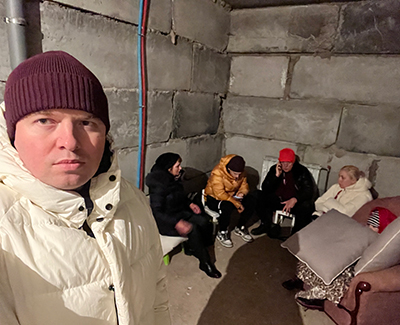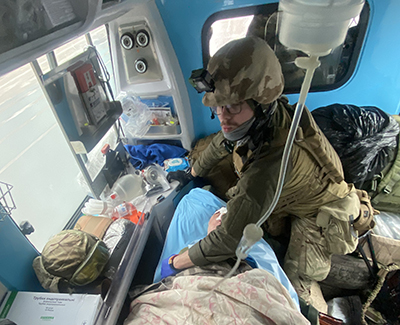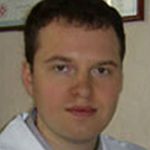Updated June 17, 2022
Dr. Oleg Parkhomenko:
We continue to teach online in P.L. Shupik National Medical Healthcare University where I work as an assistant. We conducted several courses on combat eye injuries built according to Academy materials and our own experiences during Russia's war against Ukraine.
There is a great need ... for me personally and my colleagues in Ukraine to deal properly with eye and orbital trauma and injuries. [Since the occupation of ] the Kyiv region ended, we came back to work. Most eye hospitals, state and private, work as before war providing emergency and planned surgery, but there is a significant lack of personnel, such as consultants and nurses. A lot of the population was displaced to the western part of Ukraine and abroad. Ophthalmological help in the regions of active combat actions remains very hard to get. [Many] eye drops and medicines are available in the pharmacies, such as antibacterial and anti-inflammatory drops. But the most problematic are the anti-glaucoma drugs spectrum: Many, prostaglandins for example, are hardly available.
Unfortunately, nowhere in Ukraine is safe. The air assault danger remains, which makes adjustments to the treatment process while we periodically need to go to the [bomb] shelter. Last week during working hours, there was a rocket attack with explosions that damaged a civilian building about 300 meters from our clinic.
Sitting up to few hours a day in the shelter during working hours is an opportunity to continue scientific work, which is done along with our IT specialist, on the use of artificial intelligence in analysis of OCT images. For me, changing the type of activities from just waiting to investigation or learning can significantly reduce the level of stress and anxiety.
During leisure or free time, many of the ophthalmologists take part in volunteer activities. I prepare vegetables for cooking food for the Ukrainian army. Great ideas come during war. We now prepare a dried mixture of vegetables and meat ready to prepare a national nutritious and delicious Ukrainian soup called “borsch.” If diluted with hot water, this mixture is ready to make 2.5 liters of soup, which is enough to feed five people.
Dr. Olena Hurzhii: My family and myself are still in the western Ukraine. Coming back to Kyiv doesn't still look safe. There was a bomb attack on the residential building in Kyiv couple days ago.
Although the amount of patients and variety of eye diseases are much different compared to what I usually do at home, I still can practice here, and I'm grateful to local colleagues for this opportunity. Continuing to practice ophthalmology is something from a normal previous life that helps [us] keep feeling useful and emotionally balanced.
Also, as a participant of an international project for blindness prevention led by the SEVA foundation I was able to conduct a workshop on indirect ophthalmoscopy for HIV doctors here in western Ukraine. I continue my contributions as an editor for EyeWiki® and ... as a part of the Academy's ONE® Network educational activities. I'm thankful to all my international colleagues for being able stay in ophthalmological field.
Dr. Yaroslav Voloshyn: I continue to work as a military doctor on the front line. Given the advance of the Ukrainian army, we moved to the East and South of the country. My family continues to live in the West [since] before the active hostilities. Ophthalmology is inaccessible to me, but I hope to return to civilian life soon.
March 18, 2022
When Russia invaded Ukraine, the lives and safety of millions were placed at risk. The resulting humanitarian crisis has spurred a mass exodus of Ukrainians seeking refuge and has disrupted the delivery of medical care, including ophthalmic care — severing the connection between patient and physician.
Recently, three Ukrainian young ophthalmologists, general ophthalmologists Olena Hurzhii, MD and Yaroslav Voloshyn, MD, as well as cataract surgeon Oleg Parkhomenko, MD, spoke with YO Info about how they’re coping with the crisis, how their patients are handling the emergency and what life is like inside their war-torn nation.
How have military operations disrupted medical care for Ukrainians?
 Dr. Parkhomenko:
Dr. Parkhomenko:
The military invasion by Russia has totally disrupted ophthalmic medical care in Ukraine, especially in Kyiv, Kharkiv and Mariupol. Private clinics, which provide about one-half of the country’s total eye care, are closed, and the continuation of any type of work in our branches in Kyiv, Kharkiv and Sumi is impossible and unsafe for both patients and personnel because of continuous bombardments, shootings on the streets and destroyed bridges and roads on the way to clinics.
How are ophthalmologists coping during the invasion?
Dr. Hurzhii: [As of mid-March], nearly 3 million people now have left Ukraine primarily to the European Union — and those numbers include physicians. Many more were forced to relocate internally, so there are not many doctors left in the city centers that need them. Another issue is logistics. With almost no public transportation, both doctors and patients cannot reach their hospitals and clinics.
For me in private practice, I’m mostly doing online consultation. Thankfully, there has been a large movement recently in Ukraine for telemedicine, with doctors providing care free of charge via phone calls, video chats and messaging apps. Using telemedicine, many of us are still able to provide some type of care, particularly for patients with chronic illness or those who need to change therapies because of medicine shortages. And that’s a problem because every now and then I’ll receive a message from a patient asking how he/she should replace this or that medication with an alternative because some pharmacies are closed and some are just empty or unreachable.
Dr. Parkhomenko: For ophthalmologists in state-run clinics in cities at the center of war like Kyiv, Kharkiv and Mariupol, their duties are mostly transferred to field hospitals in the basement. Up to now, we are only able to handle ocular emergencies, which are performed in a duty regimen (one to two ophthalmologists in the clinic at a time). We are hoping to perform retina and cataract surgeries soon, but there is also a lack of anesthesiologists and nurses. Periodic bombing attacks are also making surgery and especially our patients unsafe.
What is the experience on the frontline for military physicians?
Dr. Voloshyn: On the frontline, we have a significant problem with access to hospitals. Today we were caring for two injured individuals, and the closest hospital is already at 200% capacity. So we really have no place to take them. That hospital is maybe 25 minutes from the frontline, and the second closest is around 40 minutes away, but there’s a shortage in medical personnel for transport. We have one military ambulance and one driver. We have one doctor — me — and one paramedic. We can’t use a gun, so we have one armed soldier who covers us. One of the two injured men today had a foreign body in his eye and head, and so we ended up taking him to a maternity ward. It’s really hard. We’re seeing a lot of eye trauma, and we can do nothing on the frontline. All we can do is bandage the patient and run them quickly to any hospital.
 It’s a really big problem. We don’t have established military hospitals because our [front]line changes every day — one day it’s 1 kilometer forward and the next it’s 1 kilometer back. All the time we are moving. Today we also lost two villages that we were covering for three days, and so we all had to move back and begin a new search for any hospital that can help us.
It’s a really big problem. We don’t have established military hospitals because our [front]line changes every day — one day it’s 1 kilometer forward and the next it’s 1 kilometer back. All the time we are moving. Today we also lost two villages that we were covering for three days, and so we all had to move back and begin a new search for any hospital that can help us.
Is there a way to provide eye care or even general medical care in the refugee camps?
Dr. Hurzhii: Yes and no. My mother works with refugees as part of the United Nations High Commissioner for Refugees (UNHCR)—a UN agency that provides general medical care to displaced communities. The main problem with our current refugee situation is the language barrier — many volunteers speak their own language and many refugees either don’t know that language or don’t speak English. But from what I’m aware, eye care in refugee camps is very difficult simply because there are no real doctors present. The personnel are mostly paramedics who are working in an emergency capacity — handling fever or acute pain — so no high level of medical or specialized care is available.
Are there any other thoughts you’d like to share with your colleagues?
Dr. Parkhomenko: It is a difficult time. The house where I live with my family in Kyiv was out of water with no electricity, so we moved to a suburb of the capital to stay with my father — Georgii Parkhomenko, MD, PhD, also an Academy member and a cataract, cornea and refractive surgeon at one of the largest private networks in the country. There, we lived half the day in the basement and half the day in the house, changing locations depending on the timing of air assaults. After Russian tanks destroyed two houses on our street, we were forced to evacuate immediately. Eventually I came to find that my father’s location was considered by CNN to be one of the top 10 most dangerous areas in Ukraine. Fortunately, we were able to move our families and children safely to the western part of Ukraine.
[We are] helping our army to gain victory with everything we can — some of us can take weapons in their hands. Some, like me, can treat people in hospitals. — Oleg Parkhomenko, MD
Dr. Hurzhii: It’s important for the world to remember that many of us left not only our homes, but also our professions. We’ve been forced to relocate internally to areas in Ukraine where there are no opportunities to practice. And for those physicians who fled Ukraine altogether, their medical diplomas are not recognized — we as Ukrainians can’t practice in European countries. We cannot practice anywhere, and I don’t know for how long we will be able to survive without any work.
More About the Ukrainian Ophthalmologists
 |
Olena Hurzhii, MD, is a general ophthalmologist, uveitis specialist and director of medical education at the Visium Eye Care Center in Kyiv. After the invasion, Dr. Hurzhii and her family left the capital city for western Ukraine. An Academy member, she is also a contributing editor with the Academy’s ONE® Network, and in 2015, she participated in the Academy’s Rotary Host Program where she stayed with her host Academy past president Michael Brennan, MD in Burlington, N.C., and attended AAO 2015. She was nominated by the Ukranian Ophthalmological Society and the European Society of Ophthalmology and selected to participate in the Academy’s Leadership Development Program XXIV, Class of 2023, and will begin by participating in an LDP orientation session at AAO 2022 in Chicago. |
 |
Oleg Parkhomenko, MD, is a cataract surgeon and retina specialist in both private and state clinics in Kyiv. An Academy member, he is also Ukraine’s YO national representative to the European Society of Ophthalmology (SOE). After the invasion, Dr. Parkhomenko and his family also fled Kyiv to western Ukraine. |
 |
Yaroslav Voloshyn, MD, is a general ophthalmologist and refractive surgeon in Kyiv during peacetime. Now Dr. Voloshyn is a military physician. He became involved in military medicine in 2014 during Russia’s first invasion of Ukraine. |
The Academy stands in support of our Ukrainian members and the people for whom they care. Read more the Academy's position and find access to “First Aid for a Common Target of Wartime Injury: The Eye.”
Aftermath of a Missile Attack
A Ukrainian War Diary